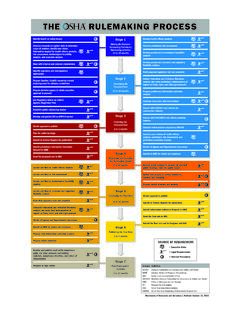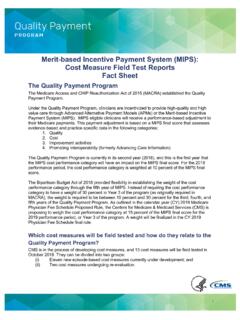Transcription of Evidence-Based Policymaking: What is it? How does it work ...
1 Evidence-Based Policymaking: What is it? How does it work? What relevance for developing countries? Sophie Sutcliffe and Julius Court Overseas Development Institute November 2005 iiContents Executive Summary iii Evidence-Based Policy: Importance and Issues iii Increasing Evidence Use: Approaches and Tools for Progressive Policymakers iv Section I: Evidence-Based Policy: Importance and Issues 1 Introduction 1 Key Issues Surrounding EBP 3 Examples of EBP 9 Translation of EBP to Developing Country Contexts 11 Summary and Preliminary Conclusions 12 Section II: Getting Evidence into Policy: Approaches and Tools Used in the UK 13 Approaches 13 Summary of Specific Tools Used by the UK Government 15 Specific Tools Used by the UK Government 16 References 44 Box 1: The five s s that limit EBP 9 Box 2: Employment Retention and Advancement (ERA) Demonstration project 10 Box 3: The literacy strategy in Britain 10 Box 4: Encouraging better use of evidence in policymaking 15 Box 5: Types of economic analysis used in economic evaluation 21 Figure 1: The Dynamics of Evidence-Based Policy 1 Figure 2: The policy cycle 5 Figure 3: The flow of evidence in the policy process 7 Figure 4.
2 Factors influencing policymaking in Government 7 Table 1: Components of policy process and different evidence issues 6 Table 2: Activities covered by the Green Book 22 Table 3: Typical steps in an RIA 23 Table 4: Different types of project 33 iiiExecutive Summary Evidence-Based Policy: Importance and Issues What is the purpose of this paper? Over the last decade the UK government has been promoting the concept of Evidence-Based policy (EBP). Our partners in the South constantly ask about what is happening in the UK regarding EBP and what can they learn from the UK experience. The aim of this work is to identify lessons and approaches from EBP in the UK which may be valuable to developing countries.
3 The issues, approaches and tools presented are based on the assumption that the reader is a progressive policymaker in a developing country, who is interested in utilising EBP. The focus is on policymakers within the public sector, rather than those working within the private sector or civil society. Where does Evidence-Based policymaking come from? Using evidence to inform policy is not a new idea. What is new and interesting however, is the increasing emphasis that has been placed on the concept in the UK over the last decade. The term EBP gained political currency under the Blair administrations since 1997.
4 It was intended to signify the entry of a government with a modernising mandate, committed to replacing ideologically-driven politics with rational decision making. EBP has now become a focus for a range of policy communities, whether government departments, research organisations or think-tanks. What is EBP? EBP is a discourse or set of methods which informs the policy process , rather than aiming to directly affect the eventual goals of the policy. It advocates a more rational, rigorous and systematic approach. The pursuit of EBP is based on the premise that policy decisions should be better informed by available evidence and should include rational analysis.
5 This is because policy which is based on systematic evidence is seen to produce better outcomes. The approach has also come to incorporate Evidence-Based practices. Why does it matter for developing countries? EBP can have an even more significant impact in developing countries; EBP tends to be less well established in developing countries than in developed ones, and therefore the potential for change is greater. Better utilization of evidence in policy and practice can help save lives, reduce poverty and improve development performance in developing countries. For example, the Government of Tanzania has implemented a process of health service reforms informed by the results of household disease surveys this contributed to over 40% reductions in infant mortality between 2000 and 2003 in two pilot districts.
6 On the other hand, the HIV/AIDS crisis has deepened in some countries because governments have ignored the evidence of what causes the disease and how to prevent it spreading. What are the issues surrounding the use of EBP? This paper highlights three main issues surrounding the use of EBP: iv(i) What evidence is used in the policymaking process ? What is clear from the literature is that policy should be informed by a wide breadth of evidence, not just hard research. Key issues include the quality, credibility, relevance and the cost of the policy. (ii) How evidence is incorporated into policymaking. Policy processes ideally involve different stages, from agenda-setting to formulation to implementation.
7 Evidence therefore has the potential to influence the policymaking process at each stage. However different evidence and different mechanisms may be required at each of the policy stages. (iii) Evidence is not the only factor which influences policymaking. It is important to acknowledge that at each stage of the policy cycle, a number of different factors will also affect policy. This occurs both at an individual level for example, a policymaker s own experience, expertise and judgement and at an institutional level, for example in terms of institutional capacity. There are also a number of constraints, which will limit the extent to which evidence can affect policy for example, the pressure to process information quickly.
8 Policymaking is neither objective nor neutral; it is an inherently political process . Despite these challenges to creating an EBP approach, there is a general consensus in the literature that a more Evidence-Based approach to policy and practice would be a positive development. Increasing Evidence Use: Approaches and Tools for Progressive Policymakers Approaches to increase the use of EBP The paper puts forward a number of approaches which will help to promote EBP. To change the status quo towards EBP within government departments, policymakers need to understand the value of evidence, become more informed as to what evidence is available, know how to gain access to it and be able to critically appraise it (Davies, 2004: 18).
9 Fundamentally, there needs to be increased communication and interaction between the research and policy worlds, such as through discussion forums and joint training. Building institutional bridges will strengthen the integration of policy and evidence, and ensure that this is sustainable. A number of ways by which policymakers can achieve this are put forward here, for example, the need to create better incentives to encourage the use of evidence and the need to encourage policymakers to own evidence. Specific tools used by the UK government The UK government uses a wide range of tools.
10 In this paper we focus on a number of these, detailing what they are, how and when they should be used and give an example of them in use. Overview and Checklist 1. Impact Assessment and Appraisal: guidance checklist for policy makers. Strategy and Policy Evaluation 2. Strategy Survival Guide 3. Magenta Book: Guidance notes on Policy Evaluation 4. Green Book: appraisal and evaluation in Central Government 5. Regulatory Impact Assessment (RIA) Ensuring Key Perspectives are Included 6. Incorporating regional perspectives into policy making toolkit (Subnational) 7. International Comparisons in Policy Making Toolkit 8.

